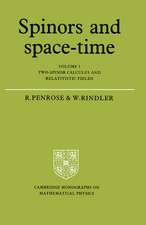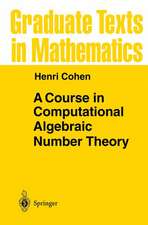Real Reductive Groups I: Pure and Applied Mathematics, cartea 132
Autor Nolan R. Wallachen Limba Engleză Hardback – mar 1988
Preț: 443.11 lei
Preț vechi: 575.47 lei
-23% Nou
Puncte Express: 665
Preț estimativ în valută:
84.82€ • 92.16$ • 71.29£
84.82€ • 92.16$ • 71.29£
Carte tipărită la comandă
Livrare economică 21 aprilie-05 mai
Preluare comenzi: 021 569.72.76
Specificații
ISBN-13: 9780127329604
ISBN-10: 0127329609
Pagini: 412
Dimensiuni: 152 x 229 x 25 mm
Greutate: 0.75 kg
Editura: ELSEVIER SCIENCE
Seria Pure and Applied Mathematics
ISBN-10: 0127329609
Pagini: 412
Dimensiuni: 152 x 229 x 25 mm
Greutate: 0.75 kg
Editura: ELSEVIER SCIENCE
Seria Pure and Applied Mathematics
Cuprins
Preface IntroductionChapter 0. Background Material Introduction 0.1 Invariant measures on homogeneous spaces 0.2 The structure of reductive Lie algebras 0.3 The structure of compact Lie groups 0.4 The universal enveloping algebra of a Lie algebra 0.5. Some basic representation theory 0.6 Modules over the universal enveloping algebraChapter 1. Elementary Representation Theory Introduction 1.1. General properties of representations 1.2. Schur's lemma 1.3. Square integrable representations 1.4. Basic representation theory of compact 9 groups 1.5. A class of induced representations 1.6. C" vectors and analytic vectors 1.7. Representations of compact Lie groups 1.8. Further results and commentsChapter 2. Real Reductive Groups Introduction 2.1. The definition of a real reductive group 2.2. Parabolic pairs 2.3. Cartan subgroups 2.4. Integration formulas 2.5. The Weyl character formula 2.A. Appendices to Chapter 2 2.A.1. Some linear algebra 2.A.2. Norms on real reductive groupsChapter 3. The Basic Theory of (g, K)-Modules Introduction 3.1. The Chevalley restriction theorem 3.2. The Harish-Chandra isomorphism of the center of the universal enveloping algebra 3.3. (g, K)-modules 3.4. A basic theorem of Harish-Chandra 3.5. The subquotient theorem 3.6. The spherical principal series 3.7. A Lemma of Osborne 3.8. The subrepresentation theorem 3.9. Notes and further results 3.A. Appendices to Chapter 3 3.A.1. Some associative algebra 3.A.2. A Lemma of Harish-ChandraChapter 4. The Asymptotic Behavior of Matrix Coefficients Introduction 4.1 The Jacquet module of an admissible (g, K)-module 4.2 Three applications of the Jacquet module 4.3 Asymptotic behavior of matrix coefficients 4.4 Asymptotic expansions of matrix coefficients 4.5. Harish-Chandra’s E-function 4.6. Notes and further results 4.A. Appendices to Chapter 4 4.A.1. Asymptotic expansions 4.A.2. Some inequalitiesChapter 5. The Langlands Classification Introduction 5.1. Tempered (g, K)-modules 5.2. The principal series 5.3. The intertwining integrals 5.4. The Langlands classification 5.5. Some applications of the classification 5.6. SL(2,R) 5.7. SL(2,C) 5.8. Notes and further results 5.A. Appendices to Chapter 5 5.A.1. A Lemma of Langlands 5.A.2. An a priori estimate 5.A.3. Square integrability and the polar decompositionChapter 6. A Construction of the Fundamental Series Introduction 6.1 Relative Lie algebra cohomology 6.2 A construction of (f, K)-modules 6.3 The Zuckerman functors 6.4 Some vanishing theorems 6.5 Blattner type formulas 6.6 Irreducibility 6.7 Unitarizability 6.8 Temperedness and square integrability 6.9 The case of disconnected G 6.10 Notes and further results 6.A Appendices to Chapter 6 6.A.1 Some homological algebra 6.A.2 Partition functions 6.A.3 Tensor products with finite dimensional representations 6.A.4 Infinitesimally unitary modulesChapter 7. Cusp Forms on G Introduction 7.1. Some Fréchet spaces of functions on G 7.2. The Harish-Chandra transform 7.3. Orbital integrals on a reductive Lie algebra 7.4 Orbital integral on a reductive Lie group 7.5 The orbital integrals of cusp forms 7.6 Harmonic analysis on the space of cusp forms 7.7 Square integrable representations revisited 7.8 Notes and further results 7.A Appendices to Chapter 7 7.A.1 Some linear algebra 7.A.2 Radial components on the Lie algebra 7.A.3 Radial components on the Lie group 7.A.4 Some harmonic analysis on Tori 7.A.5 Fundamental solutions of certain differential operatorsChapter 8. Character Theory Introduction 8.1 The character of an admissible representation 8.2 The K-character of a (g, K)-module 8.3 Harish-Chandra’s regularity theorem on the Lie algebra 8.4 Harish-Chandra’s regularity theorem on the Lie group 8.5 Tempered invariant Z(g)-finite distributions on G 8.6. Harish-Chandra’s basic inequality 8.7. The completeness of the π 8.A. Appendices to Chapter 8 8.A.1 Trace class operators 8.A.2. Some operations on distributions 8.A.3. The radial component revisited 8.A.4. The orbit structure on a real reductive Lie algebra 8.A.5. Some technical results for Harish-Chandra’s regularity theoremChapter 9. Unitary Representations and (g, K)-Cohomology Introduction 9.1. Tensor products of finite dimensional representations 9.2. Spinors 9.3. The Dirac operator 9.4. (g, K)-cohomology 9.5. Some results of Kumaresan, Parthasarathy, Vogan, Zuckerman 9.6. μ-cohomology 9.7. A theorem of Vogan-Zuckerman 9.8. Further results 9.A. Appendices to Chapter 9 9.A.1. Weyl groups 9.A.2. Spectral sequencesBibliographyIndex




























